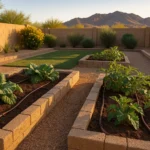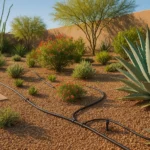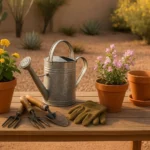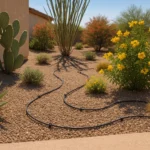Spring in Mesa brings that perfect window of opportunity when the bitter chill of winter nights has passed but the scorching summer heat hasn’t yet arrived. It’s that golden moment when our gardens can truly thrive in the desert landscape. Having worked with countless Mesa homeowners to transform their outdoor spaces, I’ve seen firsthand how a strategic spring approach can make all the difference between a garden that merely survives and one that genuinely flourishes in our unique climate.
The key to desert gardening success isn’t fighting against our environment—it’s working harmoniously with it. Mesa’s spring gardening season arrives earlier than in many parts of the country, giving us a head start but also requiring specialized knowledge. Let’s explore how to make the most of this vital growing season in our corner of the Sonoran Desert.
Understanding Mesa’s Unique Spring Growing Season
While friends and family back East might still be shoveling snow in February, Mesa gardeners are already experiencing our prime growing conditions. Our spring typically kicks off in late January to early February and extends through April—a relatively short but intensely productive window. The mild temperatures during this period, typically ranging from 65-85°F during the day and rarely dipping below 50°F at night, create ideal conditions for plant growth before summer’s intensity arrives.
What makes Mesa’s spring gardening season particularly unique is our bimodal growing pattern. Unlike cooler climates with one main growing season, we effectively have two: spring and fall. Spring in Mesa is characterized by gradually warming temperatures, increasing daylight, and typically low humidity. This combination accelerates plant growth but also increases water demands as the season progresses.
The desert soil in Mesa presents its own challenges and opportunities. Our native soil tends to be alkaline (pH 7.5-8.5) and low in organic matter, with a high mineral content. While this might seem problematic, many desert-adapted plants thrive precisely because of these conditions. For traditional garden vegetables and ornamentals, however, soil amendments become essential for success.
Essential Spring Soil Preparation Techniques
Before the first seed or transplant goes into your Mesa garden, proper soil preparation is absolutely critical. Our native desert soil, while mineral-rich, often lacks the organic matter and structure that many garden plants require. I always tell my clients that investing time in soil preparation pays dividends throughout the growing season in healthier plants and reduced water usage.
Start by conducting a simple soil test to understand your specific soil profile. Mesa soils typically run alkaline, but conditions can vary significantly even within neighborhoods. Garden centers throughout Mesa offer inexpensive soil test kits, or for more comprehensive results, the University of Arizona Cooperative Extension offers professional testing services. This baseline information helps tailor your amendments precisely to your garden’s needs.
For most garden beds, incorporate 3-4 inches of quality compost into the top 8-10 inches of soil. This single step dramatically improves soil structure, water retention, and nutrient availability. For vegetable gardens specifically, I recommend a mix of compost, aged manure (if available), and a small amount of sand to improve drainage. Work these amendments thoroughly into existing soil rather than creating raised layers, which can create problematic interfaces that hinder root growth and water movement.
Pro Tip: Mesa’s caliche layers—hard, calcium carbonate deposits that form concrete-like barriers in our soil—can severely restrict root growth and drainage. If you encounter these layers when digging, break through them with a pickaxe or digging bar. For severe cases, consider creating raised beds as an alternative to fighting with impenetrable caliche.
Strategic Plant Selection for Mesa’s Spring Climate
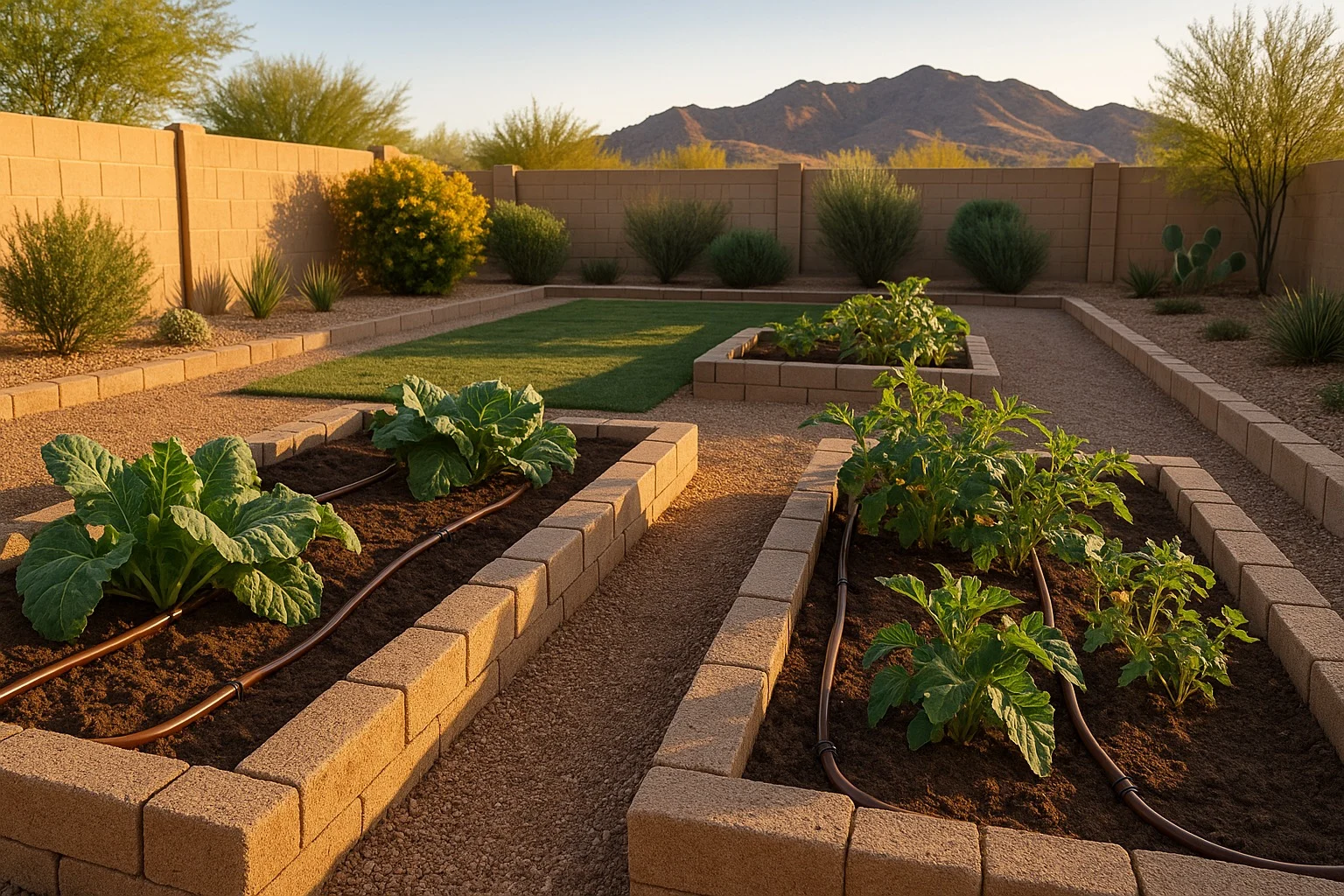
The vibrant palette of spring blooms in Mesa gardens can be breathtaking when you select the right plants for our climate. The visual transformation of a well-planned spring garden here creates a stunning contrast against our desert backdrop—imagine the brilliant orange of globe mallows, the delicate purple of penstemons, and the sunny yellow of brittlebush all set against earthy desert tones and blue Arizona skies.
For ornamental gardens, focus on plants that establish quickly during our brief spring window. Native desert wildflowers like Mexican gold poppies, lupines, and desert marigolds not only provide spectacular color but require minimal water once established. For perennial structure, consider desert-adapted shrubs such as Texas sage, creosote bush, and fairy duster, which provide year-round interest with spring flowering peaks. These plants have evolved specifically for our conditions and will reward you with sustainability and beauty.
For vegetable gardeners, spring is prime time for planting warm-season crops before summer heat arrives. Tomatoes, peppers, eggplants, melons, and squash should be planted as transplants in February to early March to give them time to establish and produce before extreme heat. Quick-growing crops like green beans, cucumbers, and corn can be direct-seeded when soil temperatures consistently reach 60°F. Remember that timing is critical—plant too late, and summer heat will prevent fruit set regardless of how healthy your plants appear.
Pro Tip: When selecting plants at local nurseries, look beyond what’s merely available and focus on what’s appropriate. National chain stores often stock the same plants regardless of local climate. Instead, visit specialized Mesa nurseries like Desert Horizon Nursery or A&P Nursery that focus on desert-adapted varieties proven to thrive in our conditions.
Water-Wise Irrigation Strategies for Spring Success
The shimmering morning light catching water droplets on newly irrigated plants creates that magical desert garden moment—but achieving water efficiency in Mesa requires more than just turning on sprinklers. Effective spring irrigation means understanding the changing water needs as temperatures rise and plants develop.
Drip irrigation remains the gold standard for Mesa gardens, delivering water precisely where needed while minimizing evaporation. For spring vegetable gardens, configure your system with emitters that can be adjusted as plants grow. Newly seeded areas might require daily light watering, while established plants benefit from deeper, less frequent irrigation. As a general guideline, most spring vegetables need about 1-2 inches of water weekly, applied in 2-3 sessions rather than daily light sprinklings that promote shallow roots.
For ornamental beds featuring native and desert-adapted plants, irrigation frequency should be reduced as plants establish. Many desert natives actually perform better with minimal supplemental water after their initial establishment period. Create hydrozones in your garden by grouping plants with similar water requirements together, allowing you to irrigate efficiently without overwatering drought-tolerant specimens or underwatering thirstier varieties.
As spring progresses into early summer, adjust your watering schedule to account for increasing temperatures. By late April, you’ll likely need to increase watering frequency while maintaining the same depth. Smart controllers that adjust based on weather conditions can be particularly valuable during this transitional period, preventing both water waste and plant stress.
Mulching Techniques for Mesa’s Spring Gardens
The contrast between a properly mulched garden bed and bare soil in Mesa is striking—not just visually, but in plant performance. The right mulch creates a protective barrier that moderates soil temperature, reduces evaporation, and suppresses weeds, all critical factors in our spring growing season. Walking through a well-mulched garden, you can almost feel the difference in the microclimate it creates—cooler, more humid, and teeming with beneficial soil life.
For vegetable gardens, organic mulches like straw, shredded leaves, or compost provide the best benefits. Apply a 2-3 inch layer around plants after they’re established and soil has warmed. This organic layer gradually breaks down, continuing to improve soil structure throughout the growing season. For tomatoes specifically, mulching helps prevent soil-borne diseases from splashing onto lower leaves during irrigation or rain, reducing common fungal problems.
For ornamental beds with desert-adapted plants, inorganic mulches like decorative gravel or crushed stone often prove more appropriate. These materials reflect heat rather than absorb it, complement the natural aesthetic of desert plants, and don’t break down in our intense sun. Apply a 2-inch layer, keeping the mulch pulled back slightly from plant stems and trunks to prevent rot and pest problems.
Pro Tip: Consider using a combination approach in transitional areas of your garden. A layer of compost covered with decorative gravel gives you the soil-building benefits of organic matter with the water-conserving and aesthetic advantages of stone mulch—a perfect compromise for Mesa’s unique conditions.
Managing Pests and Diseases in Spring
The dance of light and shadow across a spring garden reveals more than just beauty—it often highlights the first signs of potential pest issues. In Mesa, our relatively mild spring brings both beneficial insects and garden pests to life simultaneously. The key is maintaining this delicate balance rather than reaching immediately for chemical controls.
Aphids typically emerge as one of the first spring pests, clustering on new growth and flower buds. Their presence often attracts beneficial predators like ladybugs and lacewings naturally. For minor infestations, a strong spray of water often suffices to dislodge them. For heavier pressure, insecticidal soaps provide effective control without harming beneficial insects. Monitor plants regularly, paying special attention to the undersides of leaves where many pests first appear.
As temperatures warm, watch for signs of spider mites, particularly on stressed plants. These tiny arachnids thrive in hot, dry conditions and can quickly multiply on water-stressed plants. Their presence is often indicated by fine webbing and stippled, yellowing leaves. Maintaining proper irrigation helps prevent infestations, while horticultural oils offer effective control for established populations.
Disease prevention in Mesa’s spring garden focuses primarily on proper cultural practices. Fungal issues, while less common in our dry climate than in humid regions, can still emerge during spring’s cooler, occasionally damp periods. Prevent problems by watering at the soil level rather than overhead, maintaining appropriate spacing for air circulation, and promptly removing any affected plant material. For tomatoes and other susceptible crops, consider applying a layer of mulch to prevent soil-borne pathogens from splashing onto lower leaves.
Spring Fertilization Strategies for Desert Gardens
The subtle green intensification of properly fertilized plants against Mesa’s earthy backdrop creates a vibrant spring display that catches the eye immediately. However, fertilization in our desert environment requires a thoughtful approach that balances plant needs with our unique soil conditions and water conservation goals.
For vegetable gardens, incorporate a balanced organic fertilizer during your initial soil preparation. Products containing equal ratios of nitrogen, phosphorus, and potassium (such as 10-10-10) provide a good foundation. As plants develop and begin flowering, transition to formulations with less nitrogen and more phosphorus to encourage fruit production rather than excessive leaf growth. Tomatoes, peppers, and other heavy feeders benefit from supplemental feeding every 3-4 weeks throughout the growing season.
For native and desert-adapted ornamentals, fertilization needs are significantly lower. Many desert plants have evolved to thrive in nutrient-poor conditions and can actually perform poorly with excessive fertilization. For established native plantings, a single application of a low-nitrogen, slow-release fertilizer in early spring is typically sufficient for the entire year. Over-fertilizing desert plants often results in lush, weak growth that requires more water and becomes more susceptible to pest problems.
Pro Tip: Consider using compost tea as a gentle fertilizer alternative for both ornamental and edible gardens. This liquid fertilizer, made by steeping finished compost in water, provides mild nutrition along with beneficial microorganisms that improve soil health. Apply monthly as a soil drench or foliar spray for improved plant vigor without the risk of fertilizer burn.
Extending Your Spring Growing Season
The vibrant spring garden doesn’t have to surrender completely to summer’s intensity. With strategic planning and protective measures, Mesa gardeners can stretch their productive spring season well into the warming months. Imagine the satisfaction of harvesting homegrown tomatoes weeks after your neighbors have abandoned their gardens to the summer heat.
Shade cloth provides one of the most effective ways to extend the spring growing season. Installing 30-50% shade cloth over vegetable gardens creates a microclimate that can be 10-15 degrees cooler than ambient temperatures. The dappled light that filters through resembles natural tree canopy, providing sufficient sunlight for plant growth while reducing heat stress and water loss. Construct simple PVC frames or utilize existing structures to support shade cloth, ensuring it’s high enough to allow good air circulation while providing consistent coverage.
Strategic planting timing also helps extend your productive season. Succession planting—starting new crops every 2-3 weeks—ensures continuous harvests rather than a single flush of production. Heat-tolerant varieties deserve special attention when planning for late spring. Varieties like ‘Arkansas Traveler’ tomatoes, ‘Trionfo Violetto’ pole beans, and ‘Arizona’ eggplant were developed specifically to continue producing as temperatures rise. Local seed sources like Native Seeds/SEARCH offer desert-adapted varieties with proven heat tolerance.
Consider transitioning some spring crops to containers that can be moved to protected locations as summer approaches. The visual versatility of container gardens allows you to maintain productive plants while adapting to changing conditions. Large pots (minimum 5 gallons) retain moisture better than smaller containers and provide adequate root space for vegetables like peppers, eggplants, and determinate tomatoes. Position these containers where they receive morning sun but afternoon shade for optimal late-spring performance.
Preparing for Summer While Enjoying Spring
The golden light of late spring in Mesa carries a bittersweet quality for gardeners—we’re enjoying the peak of spring’s bounty while preparing for summer’s challenges. This transitional period requires both celebration of current success and strategic planning for the changing season ahead. The garden in this moment feels alive with possibility, even as we acknowledge the coming summer dormancy.
Begin summer preparation by gradually adjusting irrigation schedules as temperatures rise. Plants will need more frequent watering, but the principle of deep, infrequent irrigation still applies. Check and clean drip emitters and irrigation components to ensure they’re functioning optimally before the critical summer months. Consider installing additional emitters for established plants that will face increasing water demands. The sound of properly functioning drip irrigation provides a reassuring backdrop to late spring garden activities.
Evaluate which plants will continue into summer and which should be removed to make way for heat-tolerant replacements or prepare for fall planting. Many cool-season herbs and vegetables can be harvested completely, making room for summer crops or allowing the space to rest until fall. For plants that will continue, consider applying an additional layer of mulch to insulate roots from increasing soil temperatures. This refreshed mulch layer not only serves a practical purpose but visually rejuvenates the garden as spring transitions to summer.
Document your spring garden successes and challenges through photos and notes. This visual and written record becomes invaluable for next year’s planning. Which varieties performed exceptionally well? Which planting locations proved most favorable? What pest issues emerged and how were they resolved? This reflection process transforms each growing season into a learning opportunity that improves your Mesa gardening expertise year after year.
Harvesting and Enjoying Spring’s Bounty
The morning light streaming across a Mesa garden ready for harvest creates one of the most satisfying moments in the gardening year. There’s something deeply rewarding about gathering sun-warmed tomatoes, crisp snap peas, and fragrant herbs from plants you’ve nurtured from seed or seedling. This connection between garden and kitchen represents the culmination of all your spring gardening efforts.
Harvest timing significantly impacts both flavor and continued production. Most vegetables should be harvested in the cool morning hours when their moisture content is highest and flavors are most concentrated. For leafy greens like lettuce and spinach, picking outer leaves while leaving the growing center extends your harvest period significantly. For fruiting crops like tomatoes and peppers, regular harvesting stimulates continued flower production and fruit set. The vibrant colors of a freshly harvested spring basket—the deep reds of radishes, bright greens of herbs, and multicolored peppers—create a visual celebration of the season.
Beyond immediate consumption, consider preserving spring’s abundance for enjoyment throughout the year. Quick refrigerator pickles transform excess cucumbers and peppers into crunchy treats that last for weeks. Herbs can be dried or frozen in oil for year-round use. Tomatoes and fruits can be frozen whole for later processing when temperatures make canning less appealing. These preservation methods not only extend your enjoyment of spring’s harvest but create a tangible connection to the garden even during the dormant summer months.
Pro Tip: Create a garden-to-table tradition during peak spring harvest by hosting an outdoor meal featuring primarily ingredients from your garden. This celebration honors your gardening efforts while creating memorable experiences that deepen your connection to the growing process. Even simple dishes taste extraordinary when featuring just-harvested produce at the peak of freshness and flavor.

